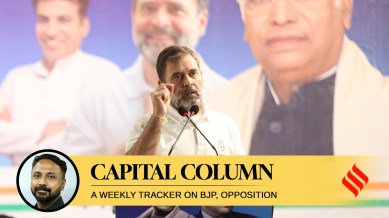Why Congress is talking of ‘the Sheila Dikshit model’ in Delhi
The party is reminding voters how the Capital changed under the former CM’s 15-year tenure. But is it too little, from too far back?

“A considerable chunk of voters who were casting their ballot for the first time had not seen the Delhi of 15 years ago. To them a Delhi with regular power, flyovers and Metro rail, as well as several new universities, was their ‘natural right’ and therefore taken for granted. They could not be expected to feel ecstatic about it.”
This was Sheila Dikshit in her memoir released in 2018 – reflecting on her and the Congress’s defeat in the 2013 Assembly elections in Delhi, ending her 15-year reign at the head of a Congress government from 1998 onwards. Reduced to just eight seats in Delhi in 2013, the party has not been able to open its account since in the Capital (in either the Lok Sabha or the Assembly).
monthly limit of free stories.
with an Express account.
Ironically, while Dikshit’s 2018 remarks indicated she believed the people may have moved on, seven years later, as it tries desperately to revive its fortunes in Delhi, the Congress is still banking on her legacy and her “governance” and “development” model, hoping to tap into the nostalgia among some voters for the same.
Last week, Congress leader Rahul Gandhi said Delhi now wants “the real development model” of Dikshit and not “the false propaganda and PR model” of Prime Minister Narendra Modi and AAP convener Arvind Kejriwal.
However, riding the goodwill of the Dikshit era is easier said than done for the Congress. If the party is just a pale shadow of itself in Delhi now, for many, the former CM’s legacy can’t be separated from the scandals towards the end of her tenure, including the Delhi gangrape that drew widespread protests, and the graft allegations surrounding the Commonwealth Games organised under her government, which were fanned by the India Against Corruption movement spearheaded by Arvind Kejriwal among others.
Senior Congress leader Pawan Khera, who was Dikshit’s OSD when she was CM, said her politics “focused on reforms” and was “a balance between welfarism and infrastructure upgradation and social justice”. “She balanced populism with development. What you see today is a total imbalance. Nobody is focusing on pollution, infrastructure upgradation, on maintenance, on social justice and harmony.”
Incidentally, when she made that surprise jump to the post of CM, her first such stint, no one expected Dikshit to have the kind of success she did. The 60-year-old was new to Delhi politics and her many challenges included a local leadership that remained at odds with her throughout her three terms.
Now, devoid of any credible face in the ranks, many Congress leaders have been reminding voters of how in Dikshit’s tenure, Delhi saw vast improvements in power and water supply, reforms in the power sector, expansion of the Metro, infrastructure upgradation like flyovers and roads, implementation of the Supreme Court directive on making CNG mandatory for public vehicles, increase in the city’s green cover, and the introduction of the Bhagidari model or “public-government partnership” that helped her push many projects including fighting pollution.
In her 2018 memoir, Dikshit wrote: “Our first formal Bhagidari meeting was held with twenty RWAs and their 200 members in 2000. Since we did not have the funds for it, Tarun Das of the Confederation of Indian Industries (CII) readily offered to help and the India Habitat Centre allowed us to use its premises… By 2003, as we neared the end of our term, as many as 2,000 RWAs had become part of Bhagidari.”
Ironically, the controversies that began with Delhi later extrapolated into reasons for the Congress’s overall downfall nationally, with the controversies surrounding the CWG and the Delhi gangrape battering the UPA government’s image.
Dikshit was cognisant of the people identifying the UPA government with hers, and wrote: “To me, it seemed as if the people were seeking a change. The idea of development as a poll plank had probably become irrelevant.”
Whether she was prescient or not, the Congress is clearly far behind in the narrative game in the Capital, even though it too has promised a raft of sops like frontrunners AAP and BJP. Its campaign does not have the visibility of the others and after missing several meetings due to ill-health, Rahul Gandhi finally hit the campaign trail on Tuesday, in the last lap.
Meanwhile, with its freebie/welfare scheme mix, the AAP has been chipping away at the Congress’s lower middle class and poor support base. Its other main vote bank, the Muslims, don’t see it as having any prospect of defeating the BJP.
With its own allies choosing the AAP over it in the Capital, the Congress also remains unclear about who its chief rival in Delhi is. On Tuesday, Gandhi, for example, concentrated his attack on Kejriwal – a strategy its INDIA allies have questioned. Gandhi said: “He (Kejriwal) came in a small car, talked about a new kind of politics… said he will change Delhi. But he was nowhere to be seen when the poor needed him, he was nowhere to be seen when violence (the Delhi 2020 riots) erupted in Delhi… He said he will usher in clean politics, and the biggest liquor scam took place in Delhi… You all must have seen his house… Kejriwal lives in a mahal, a ‘Sheesh Mahal’. That is the truth.”